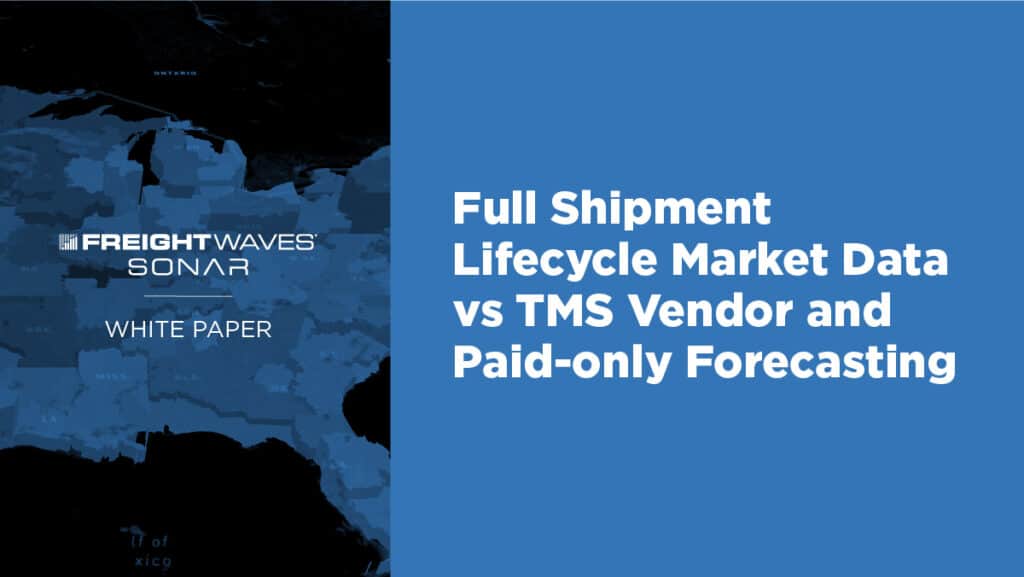While most people think of fleets of trucks when they think about the supply chain network, another mode can be even more vital. Ocean freight is a major part of the modern shipping industry and plays a role in a large percentage of overall shipping capacity. Even orders that reach their final destination by truck may very well have first traveled on a cargo ship, sailing across an ocean. This reliance on ocean freight lanes is what many logistics managers and freight brokers do not fully understand until something goes wrong within the supply chain.
And in fact, it did when the Suez Canal experienced a blockage. Look at the current Ocean Shipments Report above. The Ocean TEU Volume Index is showing a significant increase of 249.9, which is a 101.9% increase over the same time period last year! The canal blockage continues to be clearly having an effect on ports, which will translate into over-the-road transportation effects too. Let’s take a closer look at this relationship and what it means for your enterprise.
It is common knowledge that a modern-day supply chain resembles an intricate web rather than a simple one-directional chain. This interconnectedness made supply chains successful and vital parts of the global economy today. While many benefits come from this setup, the ripple effect can be far-reaching and genuinely devastating when something goes wrong. Delays can be incredibly impactful when dealing with ocean freight. Understanding this connection and recognizing the ripple effect’s scope remains essential for all shippers to understand. Even those focused predominantly on truckload orders and routing guidelines must realize the impact ocean transportation has on the entire network.
Moreover, ocean transit, while economical, also plays into total carbon emissions. And since intermodal is among the clear winners in supply chain carbon awareness, it stands to reason that any strategy for managing the ripples should look beyond a single mode. And part of that implies a need to recognize the value of real-time versus lagging data too.

Understanding the full shipment lifecycle is critical for successful transportation management. When a ship becomes delayed leaving or entering a port or experiences delays due to weather issues or mechanical problems, everything else ends up delayed as well. There’s no option to move the cargo to another vehicle as with truck fleet shipping. Cargo loaded onto a ship cannot be moved or transferred until it reaches its destination. The same is true of rail.
Delays with ocean freight stretch on throughout the entire supply chain, impacting truckload orders and everything else. All orders tied up on that vessel will remain delayed until the ship can dock and unload. Once something goes wrong with ocean freight shipping lanes, few options remain other than to wait for the ship to make it to port safely. The key is knowing when these kinds of issues have occurred early enough to try and make accommodations – if possible. Analytics help highlight disruptions early so that managers can react practically and strategically.
Additionally, that implies a need to understand what’s next within each movement. And that’s where more informed decision-making can make all the difference. Think about it. If the supply chain is indeed a web, improvements to any process, even rail or ocean, will have a net effect on total costs, including environmental costs. In turn, that may stimulate more emphasis on carbon awareness and avoiding waste. That’s the premise behind a new capability that’s coming soon from FreightWaves. FreightWaves’ Carbon Intelligence will unify the data streams to show current environmental impacts, total emissions and, most importantly, highlight opportunities to reduce them. Ultimately, it’s all about organized efforts to lower total costs and adverse effects on the planet. And it’s critical for shippers to look at the entire shipment lifecycle.
The transportation industry saw the effects of cargo delays in a powerful and impactful way with the major delays at the Suez Canal. Cargo was delayed; not just what was carried by the Ever Given, but on every other ship needing to pass through the canal. According to CNBC, this situation demonstrated the value of ocean freight analytics and the real-time impact data can have for shippers of all sizes. A wealth of available technologies exists in the modern supply chain. Everything from transportation management systems and warehouse execution systems to real-time tracking and automated communications can improve speed and functionality. Each of these generates data. That real-time data yields valuable insights into current ocean freight trends, issues and alternatives that logistics managers need to be aware of at all times.
And while COVID-19 was the significant disruption of 2020, the disruption that will shape 2021 was the Suez Canal event. The result of this disruptive event will have an impact for months and even years to come. The ripple effects of this delay of ocean freight lanes will impact the cost of fuel, produce, goods and shipping services. This event has demonstrated the need for innovative data analytics and real-time tracking within the supply chain, whether planning RFPs or simply looking for other areas of savings, much like intermodal versus truckload for rail opportunities. Disruptions within cargo lines create a ripple effect that reaches far and wide. It’s time to move to a proactive, eco-conscious network and chain. And your organization needs to embrace big data analytics and innovative technology today by requesting a SONAR demo.
